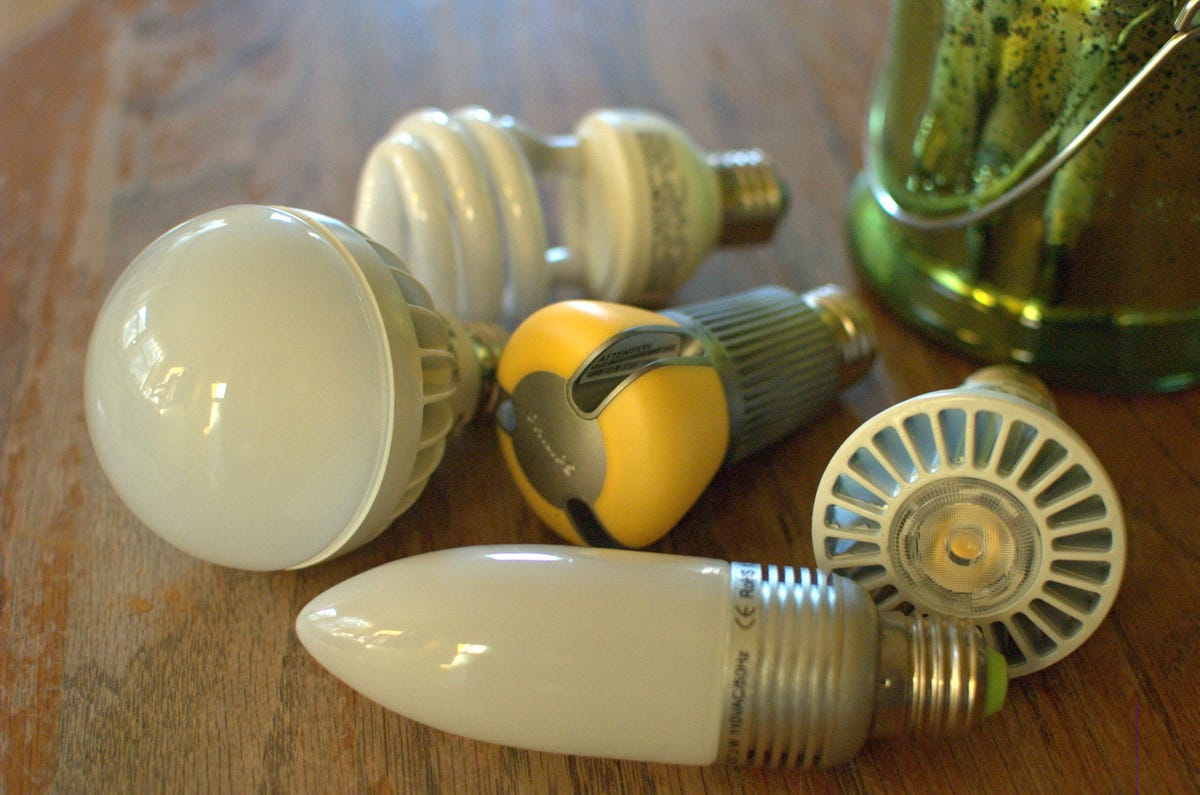Home lighting diversifies, led by LEDs (photos)
It's no longer one size fits all when it comes to lighting, as more efficient products, notably good LEDs, are coming to market.

Mixed bag of bulbs
There are now a growing set of home lighting options, led in part by a lighting energy efficiency mandate signed into law in 2007. Lighting represents about 10 percent of residential home energy use, according to the Department of Energy. Upgrading from 15 incandescent bulbs will save about $50 a year. Pictured here are examples of different types of LEDs and one CFL. What follows in this slideshow are new LEDs and other alternatives to incandescent bulbs, such as halogens.
Self-cooling inside
Switch Lighting is a new company developing an LED bulb in the traditional A19 shape. It says the bulb will have even light dispersal and last 18 years if used three hours a day. As the photo shows, the LED light sources are placed near the outside of the bulb rather than the base. The design also allows for natural cooling, helping long life. The company is planning to release a 40-watt, 60-watt, and 75-watt equivalent later this year with prices starting at less than $20. Its brightest will give off 1,150 lumens and consume 16 watts.
Lighting Sciences Group 60-watt equivalent
The design of this Lighting Sciences Group bulb shows how manufacturers are trying to make the light more even, thus making LEDs better suited for a wider range of uses, such as desk lamps and overhead fixtures. LSG has released a 40-watt equivalent already and is expected to release a 60-watt equivalent by the end of the second quarter. It will have a color rendering index of 88, give off 850 lumens, have a color temperature of 3,000 Kelvin, and consume 13 watts. It will cost $34.97. A cooler light version at 4,900K will give off 950 lumens, consume 13 watts, and cost $36.97. The look will be similar to that of the bulb pictured here, a 40-watt equivalent, available now for less than $20.
Halogen
Starting next year, light bulbs need to meet certain efficiency requirements that 100-watt incandescent bulbs will not be able to meet. One alternative besides LEDs or CLFs is halogens, which uses incandescent technology. This EcoVantage halogen from Philips consumes 72 watts but gives off as much light as a 100-watt incandescent. GE, too, has similar halogen products in the familiar bulb shape. Both will be compatible with the 2007 energy act.
Directional lighting
There are more and more LED bulbs with the traditional A19 shape that will screw into Edison sockets. But the "snowcone"-shaped bulbs give off most of their light on one side, making them suitable for a gooseneck desk lamp or overhead fixture, but not optimal for a desk lamp. This is the Pixi LED bulb where you can see how most of the light is coming from the top. This 40-watt equivalent consumes 6.5 watts and has a color rendering index of 90.
CFL on desk lamp
Notice the contrast with the previous picture. Here is a small CFL in that same lamp, where the light is more evenly dispersed and a more yellow color. The amount of light is roughly the same.
Spots
The directional light of LEDs makes a lot of sense for spotlights, such as these. I put these into an existing fixture in my kitchen. Another advantage of LEDs over CFLs is that LEDs don't degrade when you turn them on and off quickly. The life of CFLs will shorten if you turn them on and off in less than 15 minutes, according to Consumer Reports.
GE omnidirectional
Here's another design approach to dispersing light evenly. It's GE's "omnidirectional" bulb that gives off as much light as a 40-watt incandescent, with cool-colored light, and consumes 9 watts. The life is expected to be 25,000 hours, which could be well more than 20 years. It's available now for $50.
Cree bulb
The performance of LED bulbs continues to improve in terms of light output (lumens) and quality (color rendering index). Cree manufactures the LED light source that's put into light fixtures, but earlier this year it released a demonstration bulb it expects will come to market later this year. It will give off more than 800 lumens, making it a replacement for 60-watt incandescent bulbs, and consume less than 10 watts. It's designed for even light and suitable for many uses, not just spotlights.

